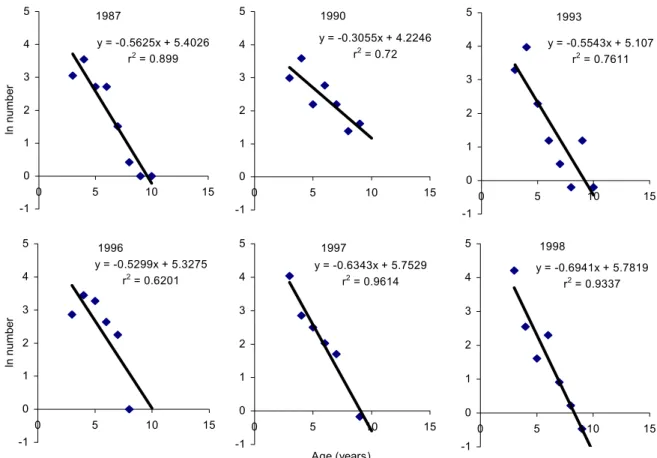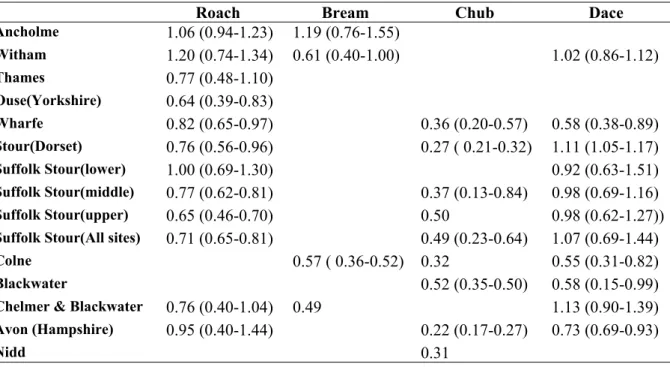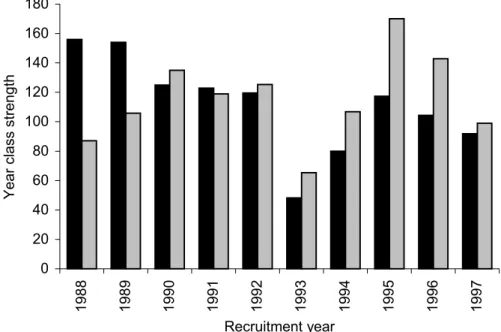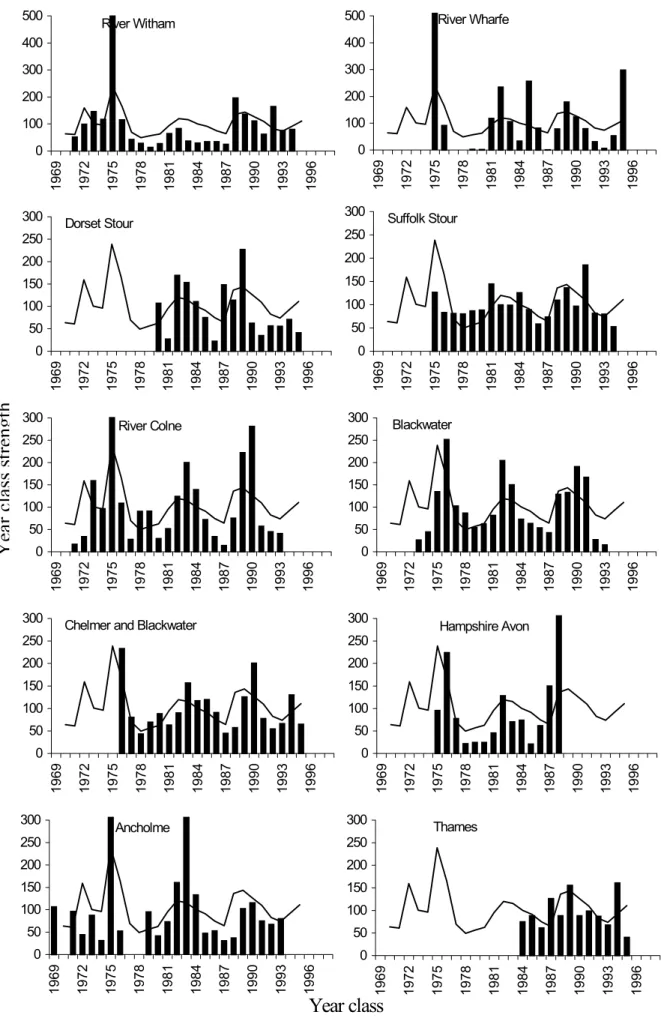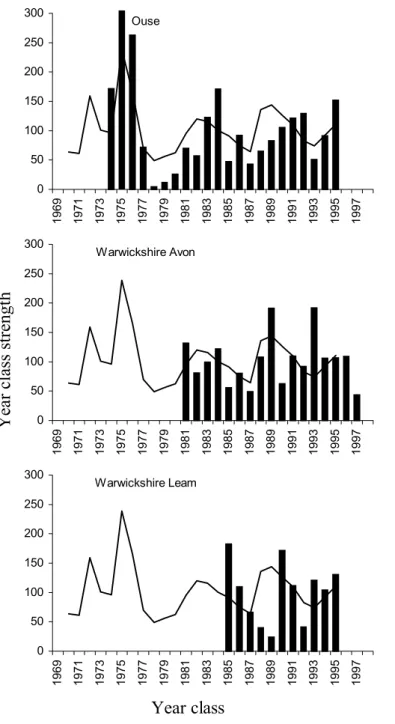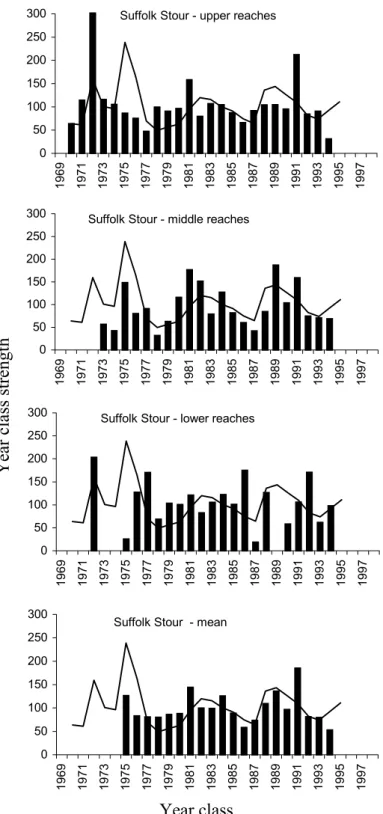Many deficiencies in data were found in terms of quality and quantity to support the assessment of factors affecting the recruitment of large fish to rivers. For the purposes of this report, these data are limited to some of the coarse fish fry monitoring sites in the Northeast Region from 1993-1997.
Environmental data Flow
These data were then analyzed by year, types of disease organisms infecting fry, species of fish affected, and incidence of infection. Further analysis was conducted to determine which The total number of degree days in each month was also examined to determine whether the variability and rate of change in temperature during different times of the year affected recruitment.
Data Analysis
Young of the year data
Cumulative degree days above thresholds and 20oC are calculated, examine the relationships between degree days and fish growth and year-class vigor, and assess whether the Agency's data are suitable for such an analysis.
Instantaneous rate of mortality (Z) and survival (S)
Year class strength
The relative strength of the year class is found by adding up the percentage contribution of each year class over all fishing years and comparing this value with the sum of the norms for the same period. The deviation of the actual %-number from the line is the measure of the strength of the year class.

Relationship between year class strength, fry growth and environmental variables
A series of linear regressions was calculated to investigate the relationships between water temperature, river flow, the position of the north wall of the Gulf Stream in latitude (the source of these data needs to be identified) and the mean length and YCS of roaches, chubs and dace and to identify key correlates between the variables . Data relating to the latitude of the north wall of the Gulf Stream for the years 1966-99 were obtained from the Plymouth Marine Laboratory website (www.pml.ac.ac.uk/pml/srp1/gulfstream/gulfstr.htm).
Comparison of Methods for Deriving Year Class Strength
The Mann YCS method indicated a strong 1988 year class with a slightly weaker 1989-YC (Fig. 3.3), the opposite of the Cowx method. For reasons discussed in Section 4.2, the Cowx method was adopted as the mechanism to derive YCS for this report.

Year Class Strength and Mortality
- Roach
- Bream
- Chub
- Dace
- Comparison of year class strength between species
The strong class of 1972 was missing from the 1981 survey and therefore the 1970 classes were dominated by the 1975 group. This is in contrast to the cockroach population picture where the 1975 class was much stronger. As described above, the strengths of the pulp year class at the mid-range of R.
The 1993 vintage was stronger than those represented in the relatively small sample of the 1998 survey. The 1982 vintage was by far the strongest of the vintages described, analogous to the R class.
Coarse Fish Fry Growth and Year Class Strength
Colne exhibited a strong year class of 1975, while the Hampshire Avon strong year class was 1976 and Suffolk R. The consistently strongest year class in seven of the eight waterways was from the 1982 batch. A strong class of 1981 was observed in chub, a year before roach and dace, but was followed by a series of poor year classes until 1995.
From the period 1985-87, the 1986 year-class was dominant in the adult population, but the average brood lengths for all three years were very similar. Similarly, the weak 1995 year class was associated with both low 0+ and 1+ growth, with the most notable effect observed in the 1+ fish, ie.
Fry Growth, Temperature and Flow .1 Inter-river temperature comparisons
- Temperature and fry growth
- Fry growth, flow and year class strength
This has been recorded since the early fish surveys in 1981 in the Northeast region (D. Hopkins, pers. comm.) and subsequently in other fish distributions of the R. A significant correlation (P < 0.05) was found between the mean length reached by 0+ group of fish in September and the number of degree days >12oC (Fig. 3.22). However, the very strong year class of 1995, which was accompanied by good growth of young (the largest boy ever recorded at this location), had only the third highest number of degree days above 12oC in the period with higher values recorded in 1997 and 1996 (Fig. 3.23).
Low YCS values were correlated with increased flow characteristics experienced in the July-September period, with no specific flow regime contributing any major significant influence. In order to investigate the likely effects of a single high-flow event affecting fry growth and YCS, the maximum mean daily flow for each month in the 1984-98 period was also examined for cockroach in the Yorkshire R.
Climatic Factors Influencing Recruitment
Relationship between number of days above basal flow rate (basal rate, basal rate x 1.5, basal rate x 2, basal rate x 2.5, basal rate x 3) in different months and length of 0+ Roach in September and year-class strength. The Ouse at Beningbrough was studied in relation to temporal variation in the latitude of the north wall of the Gulf Stream. Average 0+ fish length in September was best correlated, but not significantly, with the average annual latitudinal position of the North Wall (Figure 3.27).
Most river systems expressing a strong 1975 year class of shells fit well with August latitude, but inverse relationships were seen with August latitude for several other strong year classes, particularly in Dorset, R. Rivers such as the Colne and Blackwater suggest a lag phase between strong YCS and North Wall latitude, although it is unclear how much of this observation and that found with several other rivers is an artifact of aging drift.
Diseases of Coarse Fish Fry
- CEFAS 1996 fry parasites investigation
The same relationships were found for other river systems and species (data available from the Coarse Fisheries Science Group in Kidderminster). Roach, dace, chub Significant in high numbers, especially muscle and spine infections and after cyst rupture. The Bubwith sample showed the highest number of individual parasites per fish (n = 90), with a remarkable 586 parasites recorded out of ten fish.
Minnow (14 sites, 7 rivers surveyed) Minnow data are included to highlight comparisons with the major species studied and to emphasize the broad parasite groups detected. The parasite fauna was strikingly different from the other fish species, with Diplostomum sp., the most widespread parasite detected (at 12 of the 14 sites), found in brain tissue.
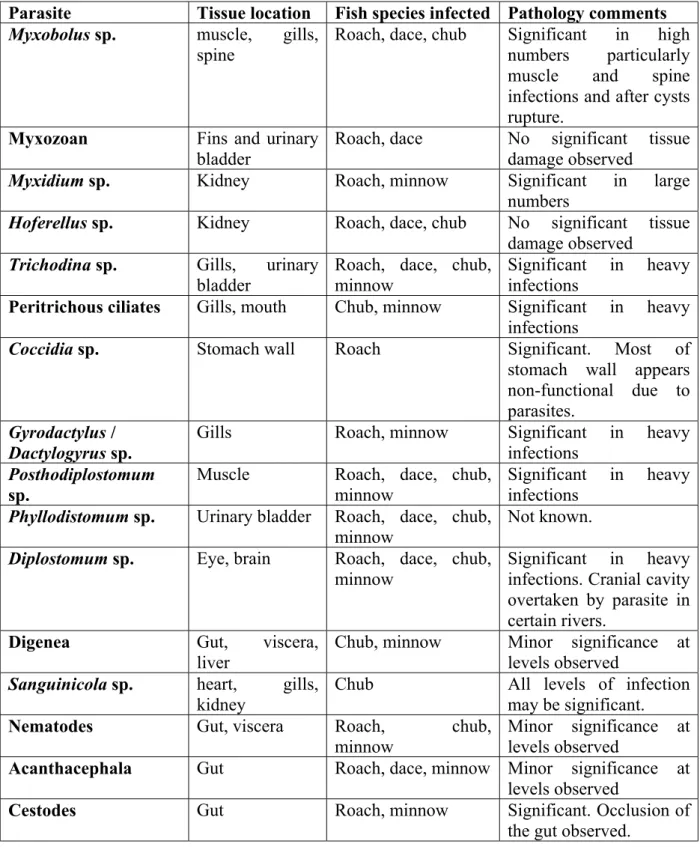
Data Quality and Availability .1 Fish population data
- Temperature and flow data
Data held by CEH relating to the long-term study of fish recruitment in the Great Ouse, identified in the data review as a key data set for Phase II, was initially considered, but costs associated with its retrieval again precluded its use in this phase of the study. Bream data was the most limited of the data obtained, relying solely on survey information from four rivers in the Anglian region. Since temperature is an important energetic component of biological systems, it was surprising to find so few records, especially in the possession of or available to biologists within the Agency.
The continuous temperature recorders linked to other telemetry systems, such as flow, operated by the water resources departments, provided the most robust temperature data sets available in the agency and appeared exclusive to the Midlands and Thames regions. This data was used in the project and some comparisons were made, such as the similarity between summer.
Year Class Strength Methods
The method developed by Linfield is also a more conservative approach as it sets an upper cut-off point when the number of fish in the oldest group falls below 1% of the total sample. Another advantage of the Cowx method is that it has no upper age cutoff criteria, and as such has the ability to assign a YCS value to the entire sample. One of the potential problems associated with any approach to calculating YCS is accurately aging individuals or providing an average length for the age key.
In addition, one of the main assumptions of the Linfield method is that the instantaneous mortality throughout life is constant for all age classes. Perhaps the greatest advantage of the Cowx and Frear and Linfield procedures is that they are simple and based on only one sample, thus obviating the need for intensive surveying on an annual or biennial basis as required by the method that was adopted by Mann (1973). .
Factors Affecting Recruitment
Temperature alone, in the form of degree-days above a threshold, does not appear to be a good predictor of year-class strength based on comparison of the Thames and Ouse barge data, although some good correlations were found to support this with the barge in the Northeastern region. facts. This parameter may be linked to the latitude of the north wall of the Gulf Stream, which could lead to autocorrelation problems. The growth and abundance of 0+ fish is probably a first key indicator for the fisheries manager in determining the likelihood of the future success of mature stocks.
The agency's data suggest that large fry are more likely to contribute to a strong year class, and yet little description has been made of the importance of "average year classes" that are present and can support the fishery. In addition, a greater understanding of the mechanisms behind increased growth rates of juveniles from the lower reaches of the river as seen in the Hampshire R.
Future Studies
To determine the factors required for the successful stocking and recruitment of the dominant whitefish species in rivers. To determine the impact of river management activities on the recruitment dynamics of the dominant whitefish populations and to assess the root causes of observed changes. Comparison of the relative strengths of the year class derived by the methods used by Mann (1973) (solid bars) and by Cowx and Frear (hatched bars).
Change in chub year-class strength in different parts of the Suffolk Stour (bar) compared to the average chub YCS for all rivers (line). Comparison of annual chub strength in the Hampshire River Avon based on 11 sites (black line) and 22 sites (shaded line). Changes in annual dace class strength in different parts of the Suffolk Stour (bar) compared to the average YCS dace for all rivers (line).
Comparison of year-class strengths of roach, carp, bream and bream based on the mean from all rivers analyzed.
